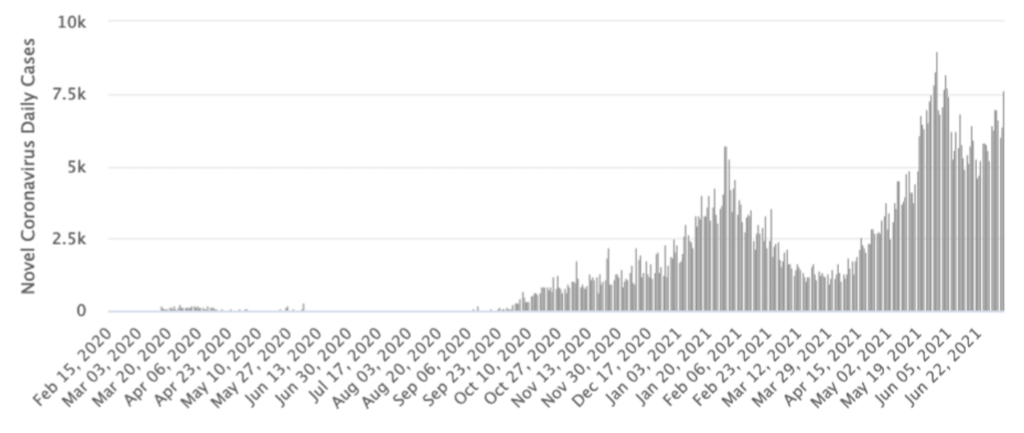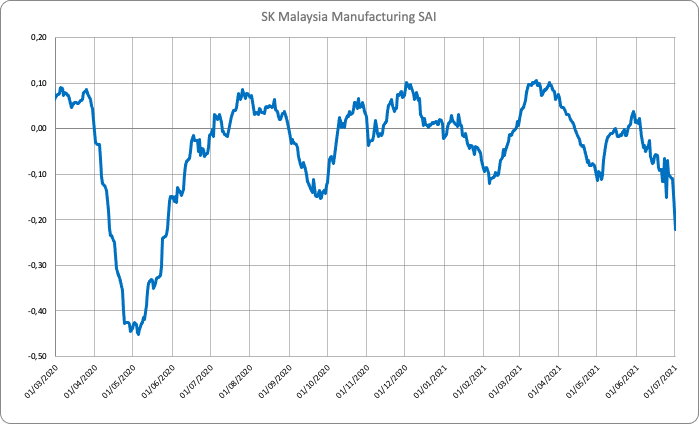Introduction
The emergence and spread of COVID-19 has forced governments around the world to implement strict measures in an attempt to curb the spread of the virus. These interventions, however, had a large economic impact, affecting industrial output, demand, and supply chains. Although essential for navigating policy responses and investment decisions, quantifying the impact remains a complicated task, mainly because of data availability and limitations. Traditional macroeconomic indicators, even if available, are often published with a delay and do not provide the desired degree of disaggregation. With over 300 satellites scanning the Earth from space, satellite imagery containing abundant information to proxy economic activities can help to improve our understanding of the economic disruptions caused by COVID-related restrictions. However, it is quite challenging to extract meaningful insights from such data as they are highly unstructured.
At SpaceKnow (SK), we bring satellite imagery down to Earth by using precise and scalable methods to estimate and map important economic indicators. In particular, we employ state-of-the-art proprietary ML/AI algorithms to analyze billions of all-weather Synthetic Aperture Radar images of key locations to provide high-frequency near real-time activity data across a variety of countries and industries. This data is currently grouped into country-specific packages that we call SK Nowcasting Solutions. Our data packages equip the end-users with unique capabilities to track crucial economy or industry-wide changes in a forward-looking manner.
In this study, we illustrate how our satellite-based nowcasting solutions can be used to track the evolution of economic impact during one month of the nationwide lockdown in Malaysia imposed in June 2021 in response to the latest surge of the pandemic.
Background: Covid-19 lockdown Malaysia
The COVID-19 situation in Malaysia has been a part of the ongoing worldwide pandemic since its very beginning. With the first cases confirmed on January 25, 2020, the pandemic escalated by the end of March when the total number of cases surged from below 30 to a staggering 2000 (source, source). In an attempt to effectively control the spread of the disease, the Malaysian government implemented various restrictive measures, including nationwide lockdowns known as Movement Control Orders (MCO). To date, three such lockdowns were implemented. The first one was in place from March 18 through May 3, 2020. The second was enforced from January 1 till March 31, 2021. Currently, the country is going through the 3rd MCO, which was imposed in response to the resurgence in COVID-19 cases in May 2021 (Figure 1) for two weeks starting from June 1 (source). However, due to the mixed success of the government measures, the lockdown was extended initially for two weeks until June 28 (source) and then indefinitely “until daily cases fell below 4000” (source, source).

During the lockdown, the Malaysian government attempted to ensure a balance between slowing the pace of the pandemic and limiting economic losses. While most economic activities were prohibited, essential and export-oriented manufacturing sectors were allowed to operate, although with some limitations. Specifically, 13 economic sectors, including Food and beverages, Electrical and electronics, Oil & gas, were allowed to operate with 60% workforce capacity; and 5 economic sectors, including Automotive, Iron and steel, and Cement, were subject to a stricter 10% manpower limit. On the services side, malls and shopping centers were closed, but services related to E-commerce, Construction and Ports, shipyards and airports operators (among 17 other essential services) were exempted from any restrictions (source). The idea behind such differentiation is clear. While the lockdown and movement restrictions would inevitably curb domestic demand, the government wanted to capitalize on the recovery of global trade and thus retain the country’s unique position in the global supply chains and export market shares in manufacturing (source). That would help to withstand the lockdown impact and minimize economic losses.
Has the government succeeded? Our unique SK Malaysia Nowcasting Solutions allows us to shed some light on this question.
Analysis: SK Malaysia Nowcasting Solutions
The first thing to start with is to recognize how remarkably well our Aggregated Manufacturing Index (Figure 2) captures the daily changes in manufacturing activities related to the evolution of COVID-19 lockdown. The index shows that manufacturing production experienced dramatic developments during the month in lockdown. Growth observed in May 2021 abruptly halted after May 29, the very next day after the reintroduction of the national lockdown was announced on May 28 (source). Since then, the index has been gradually declining, remaining weak relative to history and ultimately plunging below the lowest level reached in May 2021. Apart from the current lockdown, our index also tracks previous lockdowns very well, particularly the first one in 2020.

Note: SAI stands for Satellite Activity Index. SK Aggregated Manufacturing SAI is based on locations that are used to capture activities in the economy’s manufacturing sector such as car, steel or cement production.
Interested in our results and conclusion? You can download this Malaysia case study here or reach out at info@spaceknow.com.
Written by Olexiy Kyrychenko on behalf of SpaceKnow.